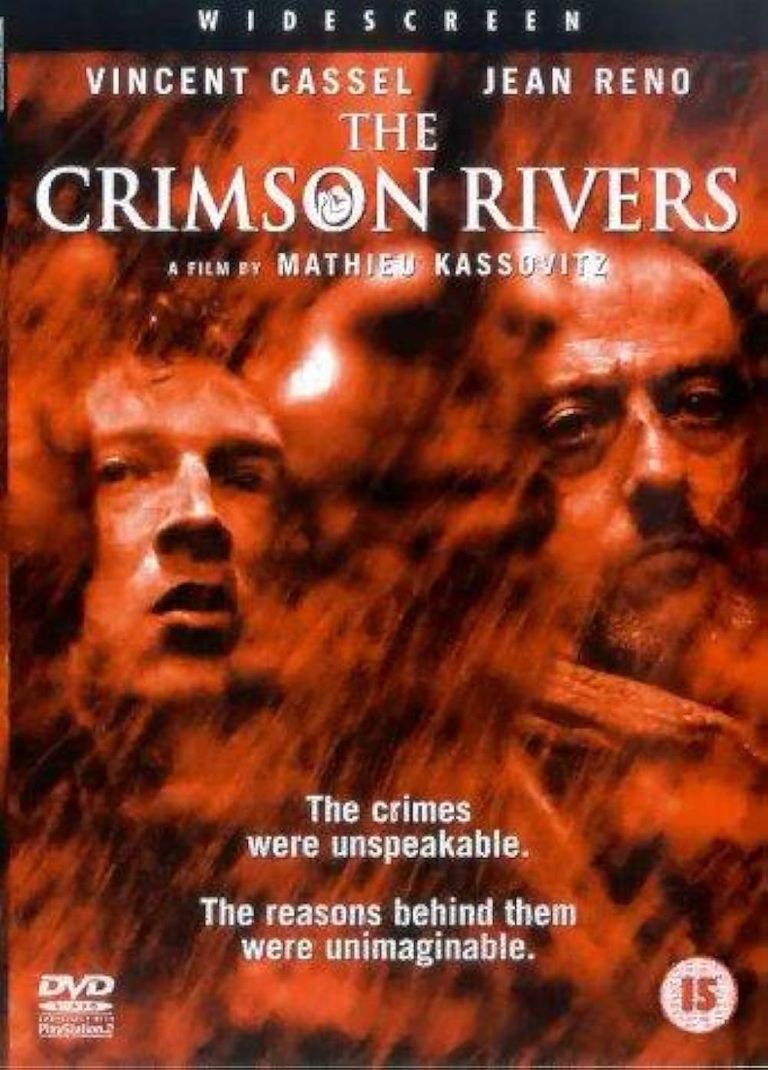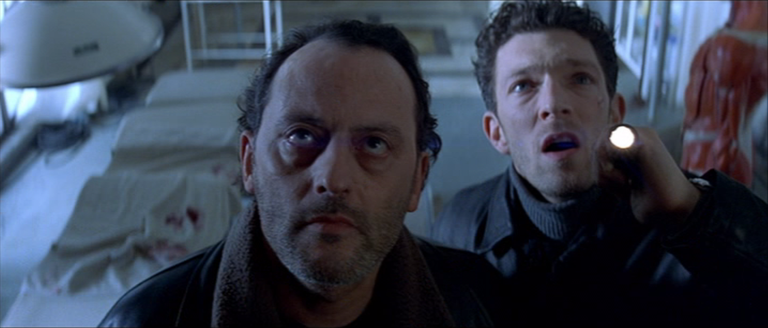
The Rivers of Purple (Les Rivières Pourpres) is a 2000 thriller film based on the novel of the same name by Jean-Christophe Grangé, which he adapted with director Mathieu Kassovitz.
The cast includes Jean Reno, Vincent Cassel, Nadia Farès and, in two brief cameos, Dominique Sanda and Jean-Pierre Cassel. The film had a sequel in 2004 with Olivier Dahan's The Purple Rivers 2: Angels of the Apocalypse.
Two heinous crimes miles apart, two seemingly unrelated cases. In Grenoble, a horribly mutilated corpse appears. At the same time, in the countryside of Lot, the grave of a girl who died in a dramatic accident in 1982 is desecrated.
Is there a link between the two events? The two policemen on the case agree, at first suspiciously, to work together in an increasingly disturbing and dangerous investigation.

Police commissioner Pierre Niemans is sent from Paris to Guernon, a university town in Haute-Savoie, to investigate a brutal murder. The body of Rémy Caillois, a university librarian, has been found in a chilling state: bound, with his eyes gouged out, his hands amputated, in a foetal position and suspended high up on a rocky wall. Closer inspection of the body reveals that the victim had been tortured and mutilated while still alive.
Niemans asks a local ophthalmologist to explain the removal of the eyes. Dr. Chernezé, who was once on staff at the local university, explains that the isolation of university staff has led to genetic wasting because professors tend to intermarry, but recently the trend has been reversed, and children in the local village are becoming increasingly ill with genetic diseases. Chernezé suggests that the killer is leaving clues as to the motive by removing body parts that are unique to each individual.
Coincidentally, police lieutenant Max Kerkerian is in the nearby town of Sarzac to investigate the desecration of the grave of Judith Hérault, a girl who died in 1982, and the theft of her photos from the primary school archive. Judith Hérault was the victim of a terrible car accident while travelling with her family. Her mother was the only survivor and was so traumatised that years later she took a vow of obscurity in a convent.
Niemans interrogates the rector and examines the librarian's flat, where he finds photos of athletic men juxtaposed with photos of genetic deformities. The rector's son and assistant, Hubert, translates the title of Caillois' dissertation as ’We are the masters, we are the slaves. We are everywhere. We are nowhere. We control the rivers of purple’. Niemans' investigations lead him to Fanny Ferreira, a glaciologist at the university and girlfriend of the rector's son, who is immediately suspected because of her climbing skills. But she denies her involvement, claiming that anyone with good equipment could have lifted the body over the cliff.
Meanwhile, the coroner informs Niemans that what was found in Caillois' eyes was acid rainwater that fell in the area not earlier than the 1970s. Niemans then arranges for Fanny to be taken to the glacier to obtain ice samples and compare them with the acid rain. Suspicious, Niemans walks through an ice tunnel containing a second frozen corpse.
Meanwhile, Kerkerian visits Judith's mother at the convent where she lives and she tells him that they had gone to Guernon's faculty hospital for help, but had been attacked by ‘demons’ on the way back and, when they had escaped, her husband and daughter had been killed in the car accident. She says that the photos were stolen to erase her daughter from history and that her face is a threat to the demons who have returned to complete their mission. Kerkerian then investigates a group of local skinheads and, after a violent brawl, learns that it was not them who violated little Hérault's grave, but a stranger driving a white car.
Kerkerian manages to locate the owner of the white car, a man from Guernon, Philippe Sertys, so he goes there to inspect the house for clues, but runs into Niemans when he tries to do the same, as the corpse he found on the glacier was Sertys himself. In the latter's house, they find stolen photos of Judith Hérault and evidence that she was involved in the breeding and training of fighting dogs, and even genetic modification as a doctor in the maternity ward of the university hospital.
When Sertys' body is analysed, it is discovered that he has been mutilated like the first corpse and his eyes replaced by glass prostheses. Niemans then returns to see the ophthalmologist Chernezé, but the doctor is already dead and almost catches the killer, who fights Niemans and manages to escape. On returning to the scene, where the murderer has written ‘I will return to the fountain of purple rivers’ in Chernezé's blood on his body, they learn that the prints on Niemans' gun belong to Judith Hérault.
In any case, everything leads to the university's medical school.
Kerkerian opens Judith's grave, which he finds empty except for the photo of a young girl, while Niemans goes to Fanny's house to tell her that, although he sees her physically capable of committing the crimes, he does not believe her guilty. When he returns to the university, the local police captain explains to him that Caillois' dissertation was almost a Nazi-style eugenics treatise, suggesting that the perfect individual could be achieved by pairing athletically gifted children with intellectually gifted ones. The ‘rivers of purple’ that often appear in the killer's writings would therefore be the blood of perfect men.
Kerkerian returns with the photo of the grave, in which Niemans recognises Fanny, and as they travel to her house, they try to piece together the history of the affair: due to genetic mutations found in the faculty's offspring, the hospital doctors had exchanged healthy children from the village with university children to strengthen their genetic make-up. They deduced that they must have swapped Fanny with one of the dead faculty children, leaving her twin, Judith, with her biological family; when Judith had been taken to the hospital, her mother had seen the photos of Fanny and realised that her twin daughter had been kidnapped, so the family had fled the hospital, pursued by the faculty members who caused the accident; The mother had then hidden Judith by passing her off as dead in the accident, as she slowly slipped into madness; Judith, now an adult, had then tracked Fanny down to reveal the truth about her true identity, and had Fanny hide from her.
Once at Fanny's house, Kerkerian and Niemans find the victims' missing hands and eyes in her basement, but no trace of the girl. Niemans gives the order to evacuate the university while he and Kerkerian head for the mountain in search of her. The duo find Fanny, but are surprised by Judith who, driven mad by the suffering and hatred that drove her to commit the crimes, attacks the two policemen. After neutralising them both, Judith orders Fanny to kill Niemans, but Niemans refuses and instead turns the gun on her. Kerkerian manages to shoot Judith, but hits Fanny in the shoulder, causing an avalanche. Judith is swept away by the blanket of snow, while all the others, sheltered behind the snowcat, are buried by it; they are later rescued by a rescue team.

Jean Reno: Pierre Niemans
Vincent Cassel: Max Kerkerian
Nadia Farès: Fanny Ferreira
Dominique Sanda: Sister Andrée
Karim Belkhadra: Captain Dahmane
Jean-Pierre Cassel: Dr. Bernard Chernezé
Didier Flamand: Rector

After the acclaimed L'Odio and the much-criticised Assassins, Mathieu Kassovitz returns behind the camera, this time with a fully genre film. There is certainly an undercurrent of social criticism within the film, aimed more at marginalised sectors than at society as a whole. Kassovitz himself declares (in an interview published on Film TV): ‘Cloning, eugenics, neo-Nazism, skinheads. There are a lot of topical issues in the film - is that why he agreed to shoot it? They are very important issues, but they are only the background’. Unfortunately.
It's certainly a real shame because the setting of the film had all the potential to bring us face to face with disturbing characters. Extremely intelligent, beautiful and athletic, ‘better’ than us in every way, and precisely for that reason capable of doing ethically terrible things with perfect conscience, as in Peter Hoeg's best novels. Here, however, the subject of criticism turns out to be not much more than the framework of the story.
However, even the characters are not the focus of the story. There is practically no attempt to bring us emotionally close to the protagonists of the story, to the extent that we will know practically nothing about the two policemen even after the end of the film (one is afraid of dogs and is not married, the other comes from the city). All the space is taken up by the investigation, the discovery of the corpses, the chases, and yet even from this point of view the plot ends up becoming confused towards the end, closed by a digital avalanche that is as cathartic as it is useless.

Los Ríos de Color Púrpura (Les Rivières Pourpres) es una película de suspenso del año 2000 basada en la novela homónima de Jean-Christophe Grangé, que adaptó con el director Mathieu Kassovitz.
El reparto incluye a Jean Reno, Vincent Cassel, Nadia Farès y, en dos breves cameos, Dominique Sanda y Jean-Pierre Cassel. La película tuvo una secuela en 2004 con The Purple Rivers 2: Angels of the Apocalypse de Olivier Dahan.
Dos crímenes atroces a kilómetros de distancia, dos casos aparentemente no relacionados. En Grenoble aparece un cadáver horriblemente mutilado. Al mismo tiempo, en la campiña de Lot fue profanada la tumba de una niña que murió en un dramático accidente en 1982.
¿Existe un vínculo entre los dos eventos? Los dos policías encargados del caso acuerdan, al principio con desconfianza, trabajar juntos en una investigación cada vez más inquietante y llena de peligros.

El comisario de policía Pierre Niemans es enviado desde París a Guernon, una ciudad universitaria de Alta Saboya, para investigar un brutal asesinato. El cuerpo de Rémy Caillois, bibliotecario universitario, ha sido encontrado en un estado escalofriante: atado, con los ojos arrancados, las manos amputadas, en posición fetal y suspendido en lo alto de una pared rocosa. Una inspección más detallada del cadáver revela que la víctima había sido torturada y mutilada en vida.
Niemans pide explicaciones a un oftalmólogo local sobre la extirpación de los ojos. El Dr. Chernezé, que en su día formó parte del personal de la universidad local, explica que el aislamiento del personal universitario ha provocado un debilitamiento genético porque los profesores tienden a casarse entre sí, pero recientemente la tendencia se ha invertido, y los niños del pueblo local enferman cada vez más de enfermedades genéticas. Chernezé sugiere que el asesino está dejando pistas sobre el motivo al extirpar partes del cuerpo que son únicas para cada individuo.
Casualmente, el teniente de policía Max Kerkerian se encuentra en la cercana localidad de Sarzac para investigar la profanación de la tumba de Judith Hérault, una niña fallecida en 1982, y el robo de sus fotos del archivo de la escuela primaria. Judith Hérault fue víctima de un terrible accidente de coche cuando viajaba con su familia. Su madre fue la única superviviente y quedó tan traumatizada que años más tarde hizo voto de oscuridad en un convento.
Niemans interroga al rector y examina el piso del bibliotecario, donde encuentra fotos de hombres atléticos yuxtapuestas a otras de deformidades genéticas. El hijo y ayudante del rector, Hubert, traduce el título de la disertación de Caillois como «Somos los amos, somos los esclavos. Estamos en todas partes. No estamos en ninguna parte. Controlamos los ríos de púrpura». Las investigaciones de Niemans le llevan hasta Fanny Ferreira, glacióloga de la universidad y novia del hijo del rector, de quien se sospecha inmediatamente por su habilidad para la escalada. Pero ella niega su implicación, alegando que cualquiera con un buen equipo podría haber levantado el cadáver por el acantilado.
Mientras tanto, el forense informa a Niemans de que lo que se encontró en los ojos de Caillois era agua de lluvia ácida caída en la zona no antes de los años setenta. Niemans consigue entonces que lleven a Fanny al glaciar para obtener muestras de hielo y compararlas con la lluvia ácida. Ante la sospecha, Niemans recorre un túnel de hielo que contiene un segundo cadáver congelado.
Mientras tanto, Kerkerian visita a la madre de Judith en el convento donde vive y ella le cuenta que habían ido al hospital de la facultad de Guernon en busca de ayuda, pero que habían sido atacados por «demonios» en el camino de vuelta y, cuando habían escapado, su marido y su hija habían muerto en el accidente de coche. Ella dice que las fotos fueron robadas para borrar a su hija de la historia y que su rostro es una amenaza para los demonios que han regresado para completar su misión. Kerkerian investiga entonces a un grupo de skinheads locales y, tras una violenta reyerta, se entera de que no fueron ellos quienes violaron la tumba de la pequeña Hérault, sino un desconocido que conducía un coche blanco.
Kerkerian consigue localizar al propietario del coche blanco, un hombre de Guernon, Philippe Sertys, por lo que se dirige allí para inspeccionar la casa en busca de pistas, pero tropieza con Niemans cuando intenta hacer lo mismo, ya que el cadáver que encontró en el glaciar era el propio Sertys. En la casa de este último, encuentran fotos robadas de Judith Hérault y pruebas de que se dedicaba a la cría y adiestramiento de perros de pelea, e incluso a realizar modificaciones genéticas como médico en la maternidad del hospital universitario.
Al analizar el cuerpo de Sertys, se descubre que ha sido mutilado como el primer cadáver y sus ojos sustituidos por prótesis de cristal. Niemans vuelve entonces a ver al oftalmólogo Chernezé, pero el médico ya está muerto y casi atrapa al asesino, que lucha contra Niemans y consigue escapar. Al volver al lugar de los hechos, donde el asesino ha escrito «Volveré a la fuente de los ríos de púrpura» con la sangre de Chernezé sobre su cuerpo, se enteran de que las huellas de la pistola de Niemans pertenecen a Judith Hérault.
En cualquier caso, todo conduce a la facultad de medicina de la universidad.
Kerkerian abre la tumba de Judith, que encuentra vacía salvo por la foto de una joven, mientras Niemans va a casa de Fanny para decirle que, aunque la ve físicamente capaz de cometer los crímenes, no la cree culpable. Cuando regresa a la universidad, el capitán de la policía local le explica que la disertación de Caillois era casi un tratado de eugenesia al estilo nazi, en el que se sugería que el individuo perfecto podía conseguirse emparejando a niños superdotados atléticamente con otros superdotados intelectualmente. Los «ríos de púrpura» que aparecen a menudo en los escritos del asesino serían, por tanto, la sangre de hombres perfectos.
Kerkerian regresa con la foto de la tumba, en la que Niemans reconoce a Fanny, y mientras viajan a su casa, intentan reconstruir la historia del asunto: debido a las mutaciones genéticas encontradas en la descendencia de la facultad, los médicos del hospital habían intercambiado niños sanos del pueblo con niños universitarios para reforzar su composición genética. Dedujeron que debían de haber intercambiado a Fanny con uno de los niños muertos de la facultad, dejando a su gemela, Judith, con su familia biológica; cuando Judith había sido llevada al hospital, su madre había visto las fotos de Fanny y se había dado cuenta de que su hija gemela había sido secuestrada, por lo que la familia había huido del hospital perseguida por los miembros de la facultad que provocaron el accidente; la madre había ocultado entonces a Judith haciéndola pasar por muerta en el accidente, mientras se sumía poco a poco en la locura; Judith, convertida en adulta, había localizado entonces a Fanny para revelarle la verdad sobre su verdadera identidad, y había hecho que ésta se escondiera de ella.
Una vez en casa de Fanny, Kerkerian y Niemans encuentran en su sótano las manos y los ojos desaparecidos de las víctimas, pero no hay rastro de la niña. Niemans da la orden de evacuar la universidad mientras él y Kerkerian se dirigen a la montaña en busca de ella. El dúo encuentra a Fanny, pero es sorprendido por Judith que, enloquecida por el sufrimiento y el odio que la llevaron a cometer aquellos crímenes, ataca a los dos policías. Tras neutralizarlos a ambos, Judith ordena a Fanny que mate a Niemans, pero ésta se niega y, en su lugar, la apunta con la pistola. Kerkerian consigue disparar a Judith, pero alcanza a Fanny en el hombro, provocando una avalancha. Judith es arrastrada por el manto de nieve, mientras que todos los demás, refugiados tras el snowcat, quedan sepultados por él; más tarde son rescatados por un equipo de salvamento.

Jean Reno: Pierre Niemans
Vincent Cassel: Max Kerkerian
Nadia Farès: Fanny Ferreira
Dominique Sanda: Hermana Andrée
Karim Belkhadra: Capitán Dahmane
Jean-Pierre Cassel: Dr. Bernard Chernezé
Didier Flamand: Rector

Tras la aclamada L'Odio y la muy criticada Assassins, Mathieu Kassovitz regresa tras la cámara, esta vez con una película plenamente de género. Ciertamente hay un trasfondo de crítica social dentro de la película, dirigida más a los sectores marginales que a la sociedad en su conjunto. El propio Kassovitz declara (en una entrevista publicada en Film TV): "La clonación, la eugenesia, el neonazismo, los skinheads. Hay muchos temas de actualidad en la película. ¿Es por eso que aceptó rodarla? Son temas de gran importancia, pero sólo constituyen el fondo." Desafortunadamente.
Sin duda es una verdadera lástima porque la ambientación de la película tenía todo el potencial para situarnos frente a personajes inquietantes. Extremadamente inteligente, bella y atlética, "mejor" que nosotros en todos los sentidos, y precisamente por eso capaz de hacer cosas éticamente terribles con perfecta conciencia, como ocurre en las mejores novelas de Peter Hoeg. Aquí, sin embargo, el tema de la crítica resulta no ser mucho más que el marco de la historia.
Sin embargo, ni siquiera los personajes son el centro de la misma. Prácticamente no hay intentos de acercarnos emocionalmente a los protagonistas de la historia, hasta el punto de que no sabremos prácticamente nada de los dos policías incluso después de terminar la película (uno tiene miedo a los perros y no está casado, el otro viene de la ciudad). Todo el espacio está ocupado por la investigación, el descubrimiento de los cadáveres, las persecuciones, y sin embargo incluso desde este punto de vista la trama acaba confundiéndose hacia el final, cerrada por una avalancha digital tan catártica como inútil.

Source images / Fuente imágenes: IMDB.


Sources consulted (my property) for the preparation of this article. Some paragraphs may be reproduced textually.
Fuentes consultadas (de mi propiedad) para la elaboración del presente artículo. Algunos párrafos pueden estar reproducidos textualmente.
| Argentina Discovery. |  |
|---|---|
| Galería Fotográfica de Argentina. |  |
| Viaggio in Argentina. |  |
| Patagonia Express. |  |

Upvoted. Thank You for sending some of your rewards to @null. Get more BLURT:
@ mariuszkarowski/how-to-get-automatic-upvote-from-my-accounts@ blurtbooster/blurt-booster-introduction-rules-and-guidelines-1699999662965@ nalexadre/blurt-nexus-creating-an-affiliate-account-1700008765859@ kryptodenno - win BLURT POWER delegationNote: This bot will not vote on AI-generated content
Thanks @ctime and curators team.